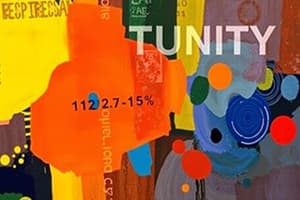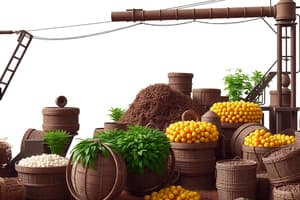Podcast
Questions and Answers
Why are clearly defined and enforced property rights essential for a well-functioning economy?
Why are clearly defined and enforced property rights essential for a well-functioning economy?
How does an impartial justice system contribute to maintaining confidence in contracts and business transactions?
How does an impartial justice system contribute to maintaining confidence in contracts and business transactions?
Which of the following scenarios BEST illustrates a negative externality?
Which of the following scenarios BEST illustrates a negative externality?
Why are public goods like national defense often provided by the government rather than private firms?
Why are public goods like national defense often provided by the government rather than private firms?
Signup and view all the answers
What is the primary concern associated with market power?
What is the primary concern associated with market power?
Signup and view all the answers
In the circular flow model, what is the primary role of households in the market for factors of production?
In the circular flow model, what is the primary role of households in the market for factors of production?
Signup and view all the answers
According to the circular flow model presented, what is exchanged in the markets for goods and services?
According to the circular flow model presented, what is exchanged in the markets for goods and services?
Signup and view all the answers
How do firms primarily interact with households in the circular flow of a market economy?
How do firms primarily interact with households in the circular flow of a market economy?
Signup and view all the answers
What is the key justification for government intervention in the market economy, as suggested in the content?
What is the key justification for government intervention in the market economy, as suggested in the content?
Signup and view all the answers
Which of the following is an example of the government promoting equity in a market economy?
Which of the following is an example of the government promoting equity in a market economy?
Signup and view all the answers
Which action by the government would least likely promote efficiency in a market economy?
Which action by the government would least likely promote efficiency in a market economy?
Signup and view all the answers
If a market is experiencing a negative externality such as pollution, what role should the government ideally play, according to the text?
If a market is experiencing a negative externality such as pollution, what role should the government ideally play, according to the text?
Signup and view all the answers
How would government intervention to remedy the market power of cartels and monopolies primarily benefit consumers?
How would government intervention to remedy the market power of cartels and monopolies primarily benefit consumers?
Signup and view all the answers
Which of the following scenarios best illustrates the application of the scientific method in economics?
Which of the following scenarios best illustrates the application of the scientific method in economics?
Signup and view all the answers
How does the concept of scarcity directly influence economic decision-making in a society?
How does the concept of scarcity directly influence economic decision-making in a society?
Signup and view all the answers
Why is the distinction between human needs and human wants important in economics?
Why is the distinction between human needs and human wants important in economics?
Signup and view all the answers
What distinguishes economics from physical sciences like physics and chemistry?
What distinguishes economics from physical sciences like physics and chemistry?
Signup and view all the answers
Considering the concept of scarce resources, which of the following examples illustrates the challenge of resource allocation?
Considering the concept of scarce resources, which of the following examples illustrates the challenge of resource allocation?
Signup and view all the answers
In the context of resource scarcity, what does the depreciation of physical capital imply for an economy?
In the context of resource scarcity, what does the depreciation of physical capital imply for an economy?
Signup and view all the answers
Which of the following is the best example of applying the Quantity Theory of Money ($P=VM/Y$) to predict the effect of monetary policy?
Which of the following is the best example of applying the Quantity Theory of Money ($P=VM/Y$) to predict the effect of monetary policy?
Signup and view all the answers
How does the scientific method, when applied to economics, address the complexities of human behavior and societal systems?
How does the scientific method, when applied to economics, address the complexities of human behavior and societal systems?
Signup and view all the answers
Which concept is NOT directly illustrated by the Production Possibilities Frontier (PPF)?
Which concept is NOT directly illustrated by the Production Possibilities Frontier (PPF)?
Signup and view all the answers
Point C lies outside the PPF. What does this imply?
Point C lies outside the PPF. What does this imply?
Signup and view all the answers
What does a point inside the Production Possibilities Frontier (PPF) indicate?
What does a point inside the Production Possibilities Frontier (PPF) indicate?
Signup and view all the answers
If a country is operating on its Production Possibilities Frontier (PPF) and chooses to produce more of one good, what is the immediate consequence?
If a country is operating on its Production Possibilities Frontier (PPF) and chooses to produce more of one good, what is the immediate consequence?
Signup and view all the answers
Which of the following factors would NOT shift the Production Possibilities Frontier (PPF) outward?
Which of the following factors would NOT shift the Production Possibilities Frontier (PPF) outward?
Signup and view all the answers
An economy improves its education system, leading to a more skilled workforce. How would this be represented using the Production Possibilities Frontier (PPF)?
An economy improves its education system, leading to a more skilled workforce. How would this be represented using the Production Possibilities Frontier (PPF)?
Signup and view all the answers
Which situation would most likely cause a country's Production Possibilities Frontier (PPF) to shift inward?
Which situation would most likely cause a country's Production Possibilities Frontier (PPF) to shift inward?
Signup and view all the answers
Technological progress leads to an increase in the productivity of producing computers, but not cars. What is the impact on the PPF?
Technological progress leads to an increase in the productivity of producing computers, but not cars. What is the impact on the PPF?
Signup and view all the answers
In a market economy, what role do prices primarily play in guiding the decisions of households and firms?
In a market economy, what role do prices primarily play in guiding the decisions of households and firms?
Signup and view all the answers
How does Adam Smith's concept of the 'invisible hand' function within a market economy?
How does Adam Smith's concept of the 'invisible hand' function within a market economy?
Signup and view all the answers
What is the primary role of firms within a market economy?
What is the primary role of firms within a market economy?
Signup and view all the answers
What is the function of households in a market economy's circular flow?
What is the function of households in a market economy's circular flow?
Signup and view all the answers
In the context of input markets, what do households typically supply?
In the context of input markets, what do households typically supply?
Signup and view all the answers
Which of the following best explains why scarcity necessitates efficient resource utilization?
Which of the following best explains why scarcity necessitates efficient resource utilization?
Signup and view all the answers
What is the primary implication of scarcity in the context of societal resource allocation?
What is the primary implication of scarcity in the context of societal resource allocation?
Signup and view all the answers
What distinguishes an entrepreneur from a typical manager within a firm?
What distinguishes an entrepreneur from a typical manager within a firm?
Signup and view all the answers
Why does the concept of opportunity cost arise when resources are scarce?
Why does the concept of opportunity cost arise when resources are scarce?
Signup and view all the answers
How do capital markets support the functioning of a market economy?
How do capital markets support the functioning of a market economy?
Signup and view all the answers
A city council decides to build a new park on a plot of land currently used as a community garden. What represents the opportunity cost of this decision?
A city council decides to build a new park on a plot of land currently used as a community garden. What represents the opportunity cost of this decision?
Signup and view all the answers
What is the primary function of product or output markets in the circular flow of economic activity?
What is the primary function of product or output markets in the circular flow of economic activity?
Signup and view all the answers
A recent graduate is deciding whether to accept a job offer or go to graduate school. Which of the following should be considered as part of the opportunity cost of going to graduate school?
A recent graduate is deciding whether to accept a job offer or go to graduate school. Which of the following should be considered as part of the opportunity cost of going to graduate school?
Signup and view all the answers
What is the MOST direct implication of unlimited human wants in an economy with scarce resources?
What is the MOST direct implication of unlimited human wants in an economy with scarce resources?
Signup and view all the answers
A small business owner is deciding whether to invest in a new marketing campaign. Which approach best demonstrates comparing benefits and costs?
A small business owner is deciding whether to invest in a new marketing campaign. Which approach best demonstrates comparing benefits and costs?
Signup and view all the answers
A country has a fixed amount of land. If it decides to dedicate more land to growing wheat, what economic concept BEST describes the consequence regarding other potential uses of the land?
A country has a fixed amount of land. If it decides to dedicate more land to growing wheat, what economic concept BEST describes the consequence regarding other potential uses of the land?
Signup and view all the answers
Flashcards
Social Science
Social Science
The study of human behavior including fields like Economics and Psychology.
Scientific Method
Scientific Method
A systematic approach to observing, hypothesizing, and testing.
Economic Problem
Economic Problem
The challenge of unlimited human wants vs. scarce resources.
Resources Scarcity
Resources Scarcity
Signup and view all the flashcards
Human Needs
Human Needs
Signup and view all the flashcards
Quantity Theory of Money
Quantity Theory of Money
Signup and view all the flashcards
Physical Capital
Physical Capital
Signup and view all the flashcards
Human Capital Development
Human Capital Development
Signup and view all the flashcards
Market Economy
Market Economy
Signup and view all the flashcards
Invisible Hand
Invisible Hand
Signup and view all the flashcards
Firms
Firms
Signup and view all the flashcards
Entrepreneur
Entrepreneur
Signup and view all the flashcards
Households
Households
Signup and view all the flashcards
Input Markets
Input Markets
Signup and view all the flashcards
Output Markets
Output Markets
Signup and view all the flashcards
Factor Markets
Factor Markets
Signup and view all the flashcards
Human Wants
Human Wants
Signup and view all the flashcards
Scarcity
Scarcity
Signup and view all the flashcards
Resource Allocation Problem
Resource Allocation Problem
Signup and view all the flashcards
Trade-Off
Trade-Off
Signup and view all the flashcards
Opportunity Cost
Opportunity Cost
Signup and view all the flashcards
Cost of a Decision
Cost of a Decision
Signup and view all the flashcards
Benefits of College Education
Benefits of College Education
Signup and view all the flashcards
Opportunity Costs of College
Opportunity Costs of College
Signup and view all the flashcards
Production Possibilities Frontier (PPF)
Production Possibilities Frontier (PPF)
Signup and view all the flashcards
Efficiency
Efficiency
Signup and view all the flashcards
Inefficiency
Inefficiency
Signup and view all the flashcards
Economic Growth
Economic Growth
Signup and view all the flashcards
Productivity
Productivity
Signup and view all the flashcards
Factors of Production
Factors of Production
Signup and view all the flashcards
Property Rights
Property Rights
Signup and view all the flashcards
Role of Government
Role of Government
Signup and view all the flashcards
Market Failure
Market Failure
Signup and view all the flashcards
Externality
Externality
Signup and view all the flashcards
Public Goods
Public Goods
Signup and view all the flashcards
Circular Flow
Circular Flow
Signup and view all the flashcards
Government Role
Government Role
Signup and view all the flashcards
Economic Equity
Economic Equity
Signup and view all the flashcards
Study Notes
Introduction to Economics
- Economics is the study of how individuals and societies allocate scarce resources to satisfy unlimited wants.
- The core concept is resource allocation.
Economic Decisions
- Households make decisions about allocating scarce resources to produce goods they want and divide them among members.
- Resources are factors of production (land, labor, capital).
Resources as Factors of Production
- Land: Natural resources (e.g., land, water, minerals).
- Labor: Human capital (e.g., quantity, quality of workforce).
- Physical Capital: Man-made resources used to produce goods (e.g., tools, buildings, equipment).
Economics as a Social Science
- Economics studies human behavior, the same as Psychology, Sociology, and Anthropology.
- It is distinct from sciences that study natural phenomena like physics and chemistry.
Scientific Method in Economics
- The scientific method is used in economics by observing events, defining problems (like money supply and prices), forming hypotheses (Quantity Theory of Money: P=VM/Y), and testing via statistical analyses of historical and cross-sectional data.
The Economic Problem
- Human wants are unlimited, but resources are scarce.
- Society must decide what to produce, how, and for whom.
Scarcity
- Resources are limited and have alternative uses.
- Choices involve trade-offs: getting more of one good means losing some of another.
- Opportunity cost is what is given up to obtain something else.
- Rational decisions compare marginal benefits and costs; take an action only if marginal benefit exceeds marginal cost.
Examples
- College education: Benefits (enrichment, opportunities) versus costs (tuition, lost income).
- Production Decisions: Increasing production beyond a certain threshold may become less profitable.
- Government Decisions: Operating a nuclear power plant; benefits (electricity) versus costs (maintenance, potential risks).
The Production Possibilities Frontier (PPF)
- Graph showing the maximum combinations of output an economy can produce given available factors of production and technology.
- Points on the PPF are efficient; points inside the PPF are inefficient; points outside the PPF are unattainable.
- Economic growth expands the PPF outwards, reflecting higher potential output.
Factors of Economic Growth
- Increases in Natural Resources (e.g., discovery of oil).
- Increases in Human Capital (e.g., Investments in education, skills).
- Increases in Physical Capital (e.g., Investment in equipment, technology).
- Technological Advancements (e.g., hybrid seeds, robotics).
Economic Systems
- Command Economies: Central government controls resource allocation.
- Market Economies: Firms and households allocate resources through decentralized decisions guided by prices and self-interest.
- Mixed Economies: Combine elements of both command and market economies.
Firms and Households
- Firms produce goods and services using factors of production.
- Households consume goods and services and own factors of production.
Input and Output Markets
- Input markets exchange resources (e.g., labor, capital, land).
- Output markets exchange goods and services.
Role of Government
- Need for governments to enforce property rights, promote efficiency, remedy market failures (like public goods, lack of competition, externalities), reduce inequality.
Studying That Suits You
Use AI to generate personalized quizzes and flashcards to suit your learning preferences.
Related Documents
Description
This lesson introduces economics, focusing on how individuals and societies allocate scarce resources to satisfy unlimited wants. It covers economic decisions made by households, factors of production (land, labor, and capital), and economics as a social science using the scientific method.




